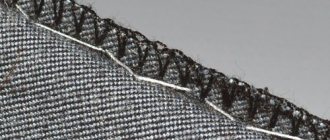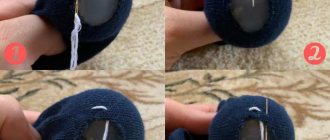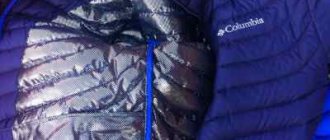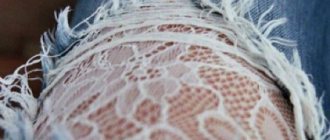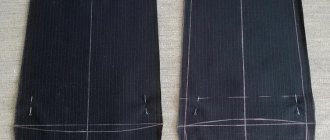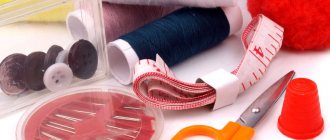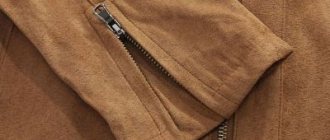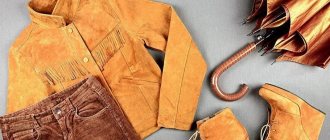What is a hidden seam and why is it needed? A blind stitch is an invisible stitch that is an absolutely universal assistant if you need to hand sew a couple of parts.
For example, trousers, children's toys, pillows, products with filler. By carefully processing the edges with a thin cloth, you will be able to successfully sew the above items. If you don’t look for a specially wired place, then it’s quite difficult to find it.
How to quietly sew a jacket at the seam
Often the jacket tears when touched by a sharp corner or object, but most often it comes apart at the seam. The seam repair operation is the simplest. You can stitch it by machine or by hand. If the item is without a lining, then simply turn it inside out, pin the tear area, sweep it so that the parts do not move, and stitch it on a typewriter.
Correctly marking the length
There is no point in adjusting the length based on an old pair of pants. Jeans become deformed during wear, and even if both pairs are the same size and model, they may fit differently when worn.
New jeans are worn with a belt and shoes. It’s good if there is a large mirror in the house, you need to look at yourself from the side so that the length of your pants in front and behind are clearly visible.
The trouser leg is folded inward and pinned. At the back, the bottom of jeans with an average width of 24-26 cm should reach the heel, wide flares cover the heel halfway. Skinny jeans 20-23 cm due to their small width fall above the heel.
Stitching up a burnt hole
A blazer can be burned by simply touching a hot object. How to arrange it? Choose a material that matches the color. Cut the patch into a diamond, square or circle shape. The patch should be slightly larger than the hole. Prepare glue for the material.
Step by step repair:
- Degrease the gluing area and the patch itself with acetone or solvent.
- Using a brush or cotton swab, apply glue to the treated surface.
- Apply the patch, closing the hole, press with a heavy object, for example, an unplugged iron.
- Hold the press for 2-3 hours so that the glue penetrates the fibers of the fabric.
The burnt hole is best hidden under a thermal sticker.
Choose a suitable sticker. Glue it with an iron through damp gauze. But not all jackets can be decorated with decor. An adult man can seal his jacket in another way: take 2 patches with an adhesive base. Squeeze one of them into the hole, place another on top, press with an iron through the gauze.
How to hem jeans using a machine
Processing the bottom edge is not difficult for a novice craftsman and allows you to save on the cost of services in the studio. For this you need an ordinary sewing machine. Even a rare model left over from your grandmother will do. Threads used for sewing should match the color of the fabric or decorative trim. It is better to select this material immediately after purchasing the item. The thickness should be such that the machine can hem the product. You won't be able to imitate a factory stitch. To give the dumplings a worn look, you can rub the seams with pumice.
Before hemming your jeans, you should correctly measure the finished length. Do the following:
- Put the item on.
- Stand without shoes in front of a large mirror.
- Tuck the excess inward and secure with pins or needles. The fold line should be near the heels at floor level. If the shoes have heels, you can hem the product, leaving it longer.
- Put on your shoes and check the results. Correct if necessary.
How to properly cut jeans and hem the bottom? Your actions:
- Place the product on a flat surface, leveling it lengthwise and crosswise.
- Draw a line to the final length using soap and a ruler.
- Set aside 1 cm down. Draw a second line.
- Measure another 1cm down before cutting the jeans. Draw a third line.
- Trim both pant legs.
- Turn the item to be shortened inside out.
- Make a hem along the first line, then along the second.
- Baste by hand.
- Make straight lines.
Decorating a cut
Jackets may be cut by a blade or other sharp object. You can hide the hole with a piece of reflective tape. Take the cobweb. Place under the awning and glue with an iron. Before working with the iron, look at the label to see what temperature the material of this product can withstand.
With this fashionable element you will kill two birds with one stone - you will disguise the hole and make your clothes visible in the dark, which means you will be safe on the roads.
Ideas for decorating a cut:
- Sew on a row of buttons, maybe of different colors, but of the same diameter.
- Glue decorative tape or iron-on sticker.
- Install rivets or buttons.
- Attach plastic fittings.
- Lay a neat seam using matching threads, connecting the sections.
- Sew on a small zipper.
A padded jacket will look like new if you cover the cut area with non-woven tape.
This material is thinner than gossamer, so it can turn into an excellent “finishing” material.
Place it under the top layer of the jacket, and on top through gauze, touch the iron with steam. The non-woven linen will melt under the iron, reliably filling the cut areas.
How to shorten jeans without a sewing machine
The bottom edge of the trousers can be finished by hand. How to hem jeans? Procedure:
- Unfold the item.
- Draw a finished length line with chalk, following the marks as a guide.
- Set the factory hem width up.
- Draw a second line.
- Turn the item inside out and iron it.
- Fold the bottom to match the decorative stitching and the second line.
- Hem the edge with neat stitches.
- Trim off any excess material left on the back.
- Sew the edges.
How to repair a jacket using applique
In this case, an applique with an adhesive base or a sticker will help. In stores you can find applique of different sizes. If with an adhesive base, then glue it with an iron. And if it’s just a design or embroidery on fabric, then you’ll have to sew it on.
How to sew an applique correctly:
- First, prepare the jacket: cut off excess threads and padding, baste the applique.
- Machine sew.
- If you don’t have a machine, then work it over the edge with threads of a suitable color. If the applique has a pattern of different colors, then the threads must be matched to match each section of the applique. Only then will it be beautiful and neat.
If the sleeve is torn, the patch must be sewn or glued on both sleeves. On the sleeve you need to make a patch much larger than the hole so that the hole does not appear again.
Invisible seam No. 4 – for knitwear and knitted items
No one is safe from a hole in their sweater. Many people know that such holes tend to spread quickly. To prevent this from happening, you should repair the product correctly. Knitwear and knitted items have their own invisible seam.
We recommend: How and with what to get rid of mold on the walls in an apartment: remove it quickly and forever, rules for working with products, preventive measures
Let's pay attention to the diagram:
Progress:
- First you need to find the threads that have broken and bring them to the wrong side.
- Next, we arm ourselves with thread to match the color of the product. We insert it into the needle.
- We tie the end of the thread to the end of the broken thread.
- We bring the needle to the front side. We pass through the 2 upper loops, then through the 2 lower ones (see diagram).
- Continue darning until all the loops are secured.
- Let's go to the wrong side. We tie the thread to the second torn end.
- Ready!
If the knitting is small, you can use a magnifying glass.
A clear example of how to properly sew up a hole on knitted items and knitwear:
What threads should you use?
Based on the quality of the selected thread, we can further talk about whether it will be possible to create an optimal seam or not.
The main requirements that exist in such a case include:
- Maximum color match to the item of clothing with which all necessary actions will be carried out;
- The thread must be straight, and in no case should it be twisted; otherwise, there is a possibility of loops forming, which will significantly reduce the speed of work and have a negative impact on the final result;
- The optimal choice is threads made from synthetic fibers that have a high level of strength; also, this variety is not capable of providing additional styling;
- One of the most acceptable options is transparent monofilament, but in order to work with it efficiently, it is extremely important to have the appropriate experience.
Shortening jeans while maintaining the frayed edge
In some cases, the user may need to shorten the jeans so that the frayed hem at the bottom remains intact. Here you will need to determine in advance the amount of shortening of the trousers, after which a fold is placed on the wrong side of the material.
Next, the fold is basted by hand. The intended product must be tried on to eliminate any errors. If everything is satisfactory, you can proceed to the final stage. The seam is sewn using a sewing machine and then ironed. Moreover, the fold should be fixed upward. The result will be cropped jeans with a frayed hem at the bottom.
Areas of application for blind seams
A seam of this type is used when performing many types of work. To ensure the full use of such seams, it is extremely important to initially form an idea of where exactly this or that variety is used.
The most popular types of hidden seams are:
- Front joining seam - suitable for repairing clothing, for example, eliminating seam waste, small tears and cuts.
- The front connector is indispensable for making toys, for example, sewing on individual parts;
- Hemming purl is used when there is a need to hem the bottom of a skirt or trousers;
- The front one is necessary for hemming the lining and sewing on sleeves, and occasionally, flaps for pockets or collars;
- Purl is used mainly when creating certain items in a decorative style (the most popular options include patchwork and quilling techniques).
Technique for hemming trousers
Methods using tape and blind stitching are described in the relevant articles, which are linked below, but here we will touch on the simplest hemming using a sewing machine.
After fitting and marking, we trim off the excess fabric. The resulting edge should be overcast with an overlocker - this way it deteriorates less and retains a pleasant appearance.
Now, more about the stages of hemming pants:
- First of all, we sweep the trouser braid along the level of the hem of the trousers;
- the stitching is carried out along special textured stripes around the entire circumference;
- when you go through the entire circle and approach the overlap of the ends, you should lower the needle and raise the foot of the sewing machine;
- Sew a seam across the tape and proceed to stitching the other edge of the tape;
- now iron the trouser tape;
- we bend the trouser leg and stitch it with suitable threads, or manually sew a blind seam;
- iron the seams and enjoy the excellent trousers.
The trouser tape should protrude 0.1-0.2
I would like to draw your attention to one more nuance. To prevent the trousers from fraying in the fold of the hem, the trouser tape should protrude from the edge of the hem by 0.1-0.2. It's about the same as in this photo.
To make this operation easier, mark with chalk a line to which you will apply the edge of the tape when stitching. It is not necessary to stitch along the tape at 0.1-0.2. Only a professional seamstress can have such precision. You can stitch at 0.4-0.5, and then use an iron to “lay out” the hem exactly at 0.1-0.2.
Fringe as decoration
The raw hem of jeans continues to be a fashion trend. You can make fringe yourself.
The only condition is that the denim fabric must be made of cotton, and the amount of elastane should not exceed 20%. To bend, you only need to have scissors and tweezers on hand.
Work progress:
- Mark the desired length on the product and the fringe area;
- Part of the lower edge of the trouser leg with future fringe is cut into several strips;
- At the next stage, the master’s main task is to carefully pull out the blue threads using scissors or a thick needle, leaving only white ones.
The listed methods for shortening jeans will help you get a beautiful and finished item. You can add your own ideas and unusual solutions.
Price for hemming jeans
Processing of the bottom of the product can be inexpensively ordered from the studio. The argument in favor of professional hemming is the greater thickness of the fabric. A regular machine may not be able to cope with this task. The industrial equipment used by tailors in the studio is designed for these operations. The cost of hemming the bottom of the product depends on the complexity of the work. The price of the service ranges from 180 to 800 rubles.
- Omez - what it is used for, instructions and reviews
- Hellebore - planting and care in open ground. How to care for hellebore flowers, photo
- Pickling mushrooms: home recipes
